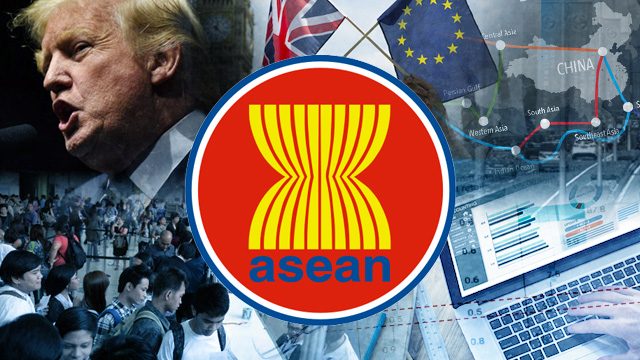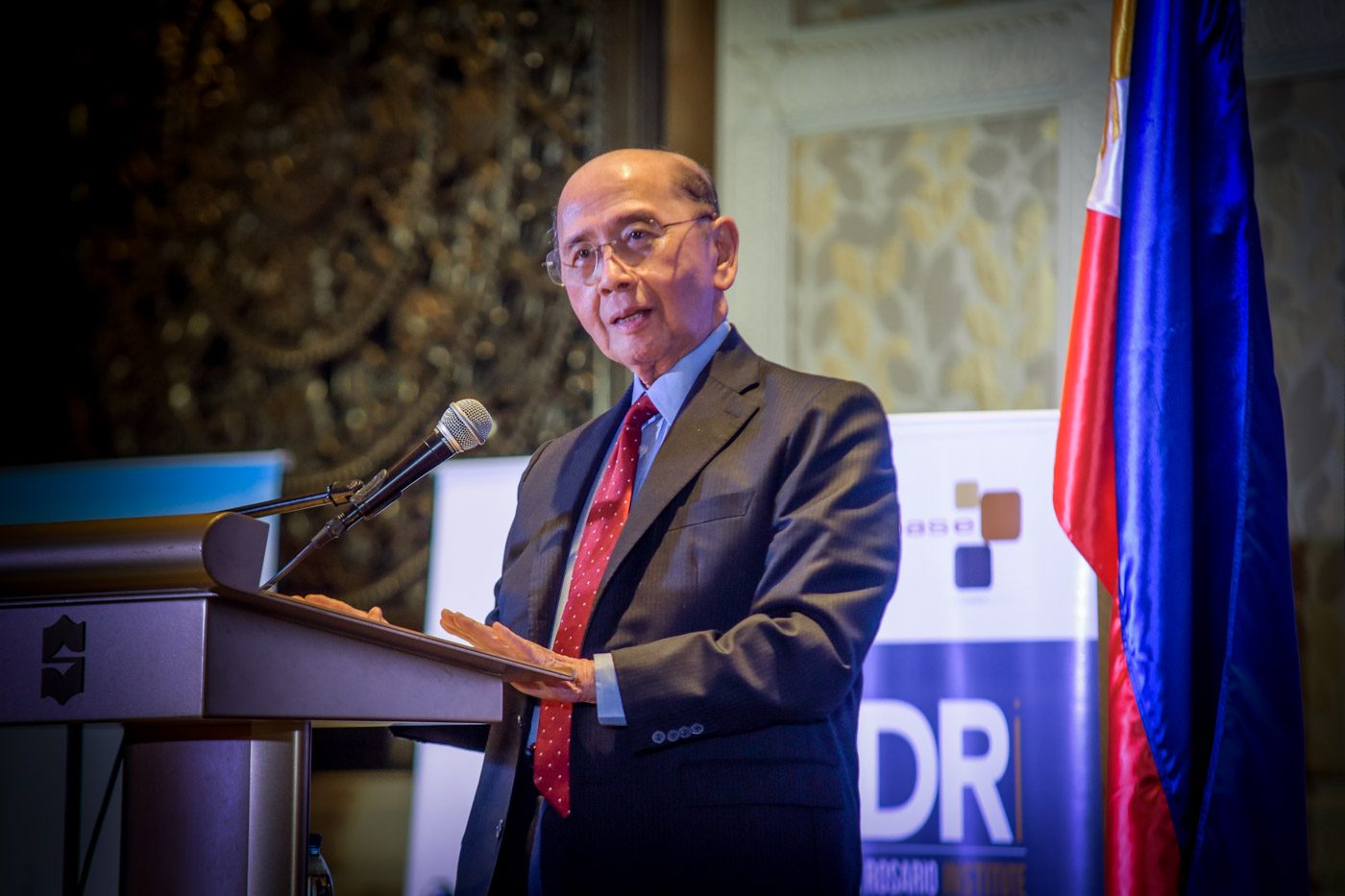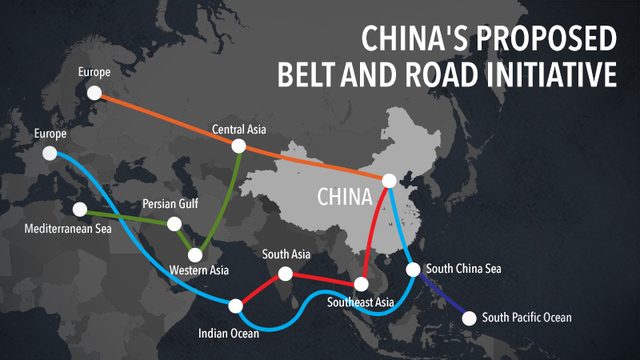SUMMARY
This is AI generated summarization, which may have errors. For context, always refer to the full article.

MANILA, Philippines – The 10 nations that collectively make up the Association of Southeast Asian Nations (ASEAN) have ridden globalization to become a major force in the global economy.
Now, however, as the world’s largest economy, the US, threatens to turn inwards, ASEAN will have to step up to navigate the suddenly choppy seas of the global trade, according to a group of former top officials at a Stratbase ADR Institute conference on Wednesday, November 8.
“ASEAN’s embrace of globalization was largely responsible for ‘this [economic] transformation, it drove deeper integration among its members and with the global economy, that is why we are the 4th largest economy [combined] in the world,” said former foreign secretary Roberto Romulo.
Romulo noted, however, that the world order of economic liberalism that enabled globalization, or as he put it, “Pax-Americana, a collation of like-minded countries led by the United States” has all but vanished.
“Unfortunately this state of grace and certainty is no longer with us. We now live in a world rife with uncertainties…what happened in 2017 was breath-taking in both speed and unpredictability. At its roots is the growing number of people that have come to the conclusion that integration and globalization was not what it was cut out to be; that all boats rise with the rising tide,” he explained.
While events like Brexit and rising nationalism in the EU have contributed to this, Romulo pointed to the election of Donald Trump as US president and his ”America first” policy as having had the most impact in creating the current geopolitical instability.
A major indicator of this has been the US’ pullout in the long-negotiated Trans-Pacific Partnership (TPP) which would have seen ASEAN, along with all the major economies of Asia and the Pacific – save for China – linked together in a huge free trade deal.
This was also followed by the renegotiations of the North American Free Trade Area (NAFTA) as well as the Trump administration’s attempts to curb the American firms’ trend of relocating and outsourcing services and production to other nations, which got the BPO industry in the country worried,

China and RCEP
America’s gradual turn inwards also coincides with China’s rising power and openness to trade with ASEAN.
Nowhere is this more apparent than in its Belt and Road initiative that aims to connect countries of Asia, Europe, and Africa to each other primarily through infrastructure projects to be funded, in part or in whole, by China.
Romulo pointed out that as economic power, China has also become more adept at its carrot and stick strategy, recalling how China banned Philippine bananas and halted Chinese tourists from visiting the country in response to the UN Permanent Court of Arbitration case the Philippines brought against it.
He also noted that in the promise of more than P20 billion in development aid and investment by China to the Philippines, ”we are now seeing the reverse as we downplay winning the case”.
The diminution of the TPP has also led to high hopes for the China-led Regional Comprehensive Economic Partnership (RCEP).
Romulo described RCEP “for now, as the only game in town which will expand ASEAN’s reach to a market of 3.4 billion people with a combined GDP of over $23 trillion, making it the world’s biggest free trade zone surpassing the EU and NAFTA in size.”
Senior officials from the countries wishing to be involved met in South Korea for the 20th time last week before the upcoming ASEAN Summit to put the finishing touches on the deal’s key elements.
Romulo noted, however, that negotiations have so far been opaque so that the outcome of the deal is uncertain. Even Japan has also recently led efforts to revive the TPP deal minus the US.

Deeper integration and focus on SMEs
In response to this new world order, Romulo said ASEAN nations have to deepen the integration of their economies.
While noting that inter-ASEAN trade and investments have grown markedly in the last 50 years, Romulo said it seems to have “plateaued at 25% for trade and around 20% for foreign direct investment”.
This is “not enough to achieve real integration, being well-below what the nations of the EU [European Union] achieved at a comparable stage,” he added.
One aspect where ASEAN is on track is the elimination of tariffs on goods, having thus far removed around 99% of them.
Romulo said, however, that more work is needed in trade facilitation, notably in harmonizing rules of origin, creating uniform customs and procedures throughout the 10 nations, removing non-tariff barriers, and enhancing the free flow of labor.
The former DFA secretary also highlighted the fact that the current ASEAN charter has “no teeth” when it comes to non-compliance. Amending it to penalize countries for not following rules would definitely speed up economic integration.
Former trade secretary Gregory Domingo, for his part, pointed out that micro and small enterprises (MSMEs) have to be put at the center of ASEAN policy.
“MSMEs account for up to 99% of businesses in ASEAN so [policymakers] should be concerned. They also comprise a big part of the anti-trade sentiment because they don’t feel the benefits of free-trade agreements,” he said.
“If you are a small business, you see the influx of goods coming from overseas, mostly from big firms and they are displacing you, but you don’t feel like you have the opportunity to take advantage of the markets in other countries,” he explained.
The former trade secretary noted that this is because exporting products, even around ASEAN, requires an average of over 30 documents. Most MSMEs simply do not have the manpower to be able to process them and in effect end up being locked out.
As such, one priority area is simplifying export regulations to allow even small businesses a chance to sell to a wider market.
Two years ago at the Asia Pacific Economic Cooperation, linking SMEs to global value chains (GVCs) was seen as a potential breakthrough solution, but Domingo has since changed tack to focus on the opportunities of the digital economy.
“GVCs means that you are supplying the big firms but really how many MSMEs can supply the big-time players, even if we realize 100% of what they are trying to now, that would be a tiny assistance to the millions of MSMEs that exist,” Domingo said.
“We have to do more than that and maybe e-commerce can be the great equalizer because it allows you to go across borders. But that is not enough. Policy makers really have to focus on e-commerce, particularly in regulation and taxation, to make sure MSMEs can really get export opportunities through it,” he added.

Indeed it is in new digital technology where ASEAN really shows the most potential, both as consumers with a population of more than 650 million people and as a producer – as shown by tech firms started in the region like Grab, Go Jek, and Traveloka.
This is only enhanced by its other advantages, young demographics, a rising middle class, and relatively low labor costs as noted by Hua Fung Teh, a principal at global private equity firm TPG Capital and former Singapore trade official.
Teh pointed out that ASEAN’s middle class is projected to rise to 400 million by 2020. The average cost of labor in Vietnam is $7 a day, Malaysia’s is at $9 a day, compared to China’s average of $28.
While acknowledging that doing business in ASEAN can be inefficient, Teh said that the prevailing view is that ASEAN is in the sweet spot where the opportunities far outweigh the challenges.
More and more Western private equity firms are setting up offices to cover Southeast Asia with many Japanese and Chinese funds following suit, he said, adding that this will only increase with the Belt and Road initiative.
“To be a good private equity practitioner, you need the right balance of efficiency, but also inefficiency. You need enough efficiency in the market so you have good enough quality data and insight to make a decision, but also enough inefficiency so you see opportunities that others don’t,” Teh explained.
He continued; “If everything was perfect, there will be no money to be made, and today ASEAN strikes a good balance between the two. It’s a great place to be an investor.” – Rappler.com
Add a comment
How does this make you feel?
There are no comments yet. Add your comment to start the conversation.